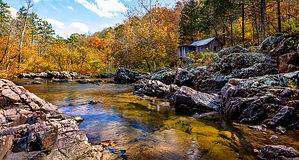Zone 8, with its mild winters and warm summers, creates an idyllic paradise for fruit trees to prosper. Whether you’re a seasoned gardener or a novice with a green thumb, exploring the diverse options available in this zone will surely leave you amazed. In fact, zone 8 is one of the best zones for growing fruit trees in North America!
Dive into the realm of tasty delights, where apples, pomegranates, and pears grow in abundance. They add a burst of zesty goodness to your garden. Venture further and discover the wonders of stone fruits like peaches, plums, and cherries. They grace the landscape with their luscious sweetness. But before we look at our list of fruit trees that grow in Zone 8, let’s learn a bit about what Zone 8 actually is.
What is Zone 8?
USDA Hardiness Zone 8 refers to a specific geographical area in the United States. It is characterized by its average minimum winter temperatures. The United States Department of Agriculture has divided the country into 11 different hardiness zones, each representing a specific range of temperatures that plants can tolerate. Zone 8 encompasses regions with milder winters compared to colder areas in the northernmost parts of the country.
In Zone 8, the average coldest winter temperature is anywhere from 10 to 20 degrees F. This relatively moderate climate makes it suitable for a wide variety of plant species to thrive. Gardeners and horticulturists in Zone 8 can grow a diverse range of plants, including both cool-season and warm-season crops.
Some common states that fall under USDA Hardiness Zone 8 include parts of the southern United States, such as parts of Texas, Louisiana, Georgia, and the Pacific Northwest, including areas of Oregon and Washington.
The mild winters in Zone 8 allow for an extended growing season, which means gardeners have the opportunity to cultivate a wide selection of flowers, fruits, and vegetables. However, it’s essential to consider factors like soil quality, sunlight exposure, and local microclimates when planning a garden in this zone.
Despite the relatively mild temperatures, extreme weather events, such as occasional freezes or heatwaves, can still occur in Zone 8. Gardeners should stay vigilant and take measures to protect their plants during these episodes to ensure successful growth and survival.
With all of this in mind, let’s look at some trees that grow well in Zone 8!
1. Apples
Apples grow exceptionally well in USDA Hardiness Zone 8 due to the favorable climatic conditions that this region offers. Zone 8 encompasses parts of the southern United States and the Pacific Northwest, and it experiences milder winters compared to colder zones in the north. This moderate climate plays a key role in supporting the successful cultivation of apple trees.
One of the primary reasons apples thrive in Zone 8 is the relatively mild winter temperatures. Apple trees require a certain number of chill hours during the winter to break dormancy and set fruit in the following growing season. In Zone 8, the winter chill is sufficient for this process, ensuring that apple trees undergo the necessary rest period before entering their active growth phase in spring.
Just as well, the extended growing season in Zone 8 allows apple trees to develop and mature properly. The longer period of warm weather provides ample time for the blossoms to be pollinated and the fruits to reach their full size and sweetness. The risk of early frosts is also lower, giving apples more time to ripen on the tree, resulting in better flavor and texture.
The well-drained soils commonly found in Zone 8 also contribute to apple tree health. Apples prefer soil with good drainage to prevent waterlogging and root rot, which can be detrimental to their growth. The suitable soil conditions in this zone promote strong root development and efficient nutrient uptake, enhancing the overall health and productivity of apple trees.
Furthermore, the temperate climate of Zone 8 helps to minimize the incidence of diseases and pests that often plague apple trees in more humid and warmer regions. While no location is entirely immune to pests and diseases, the reduced risk in Zone 8 allows for better management and control, leading to healthier apple crops.
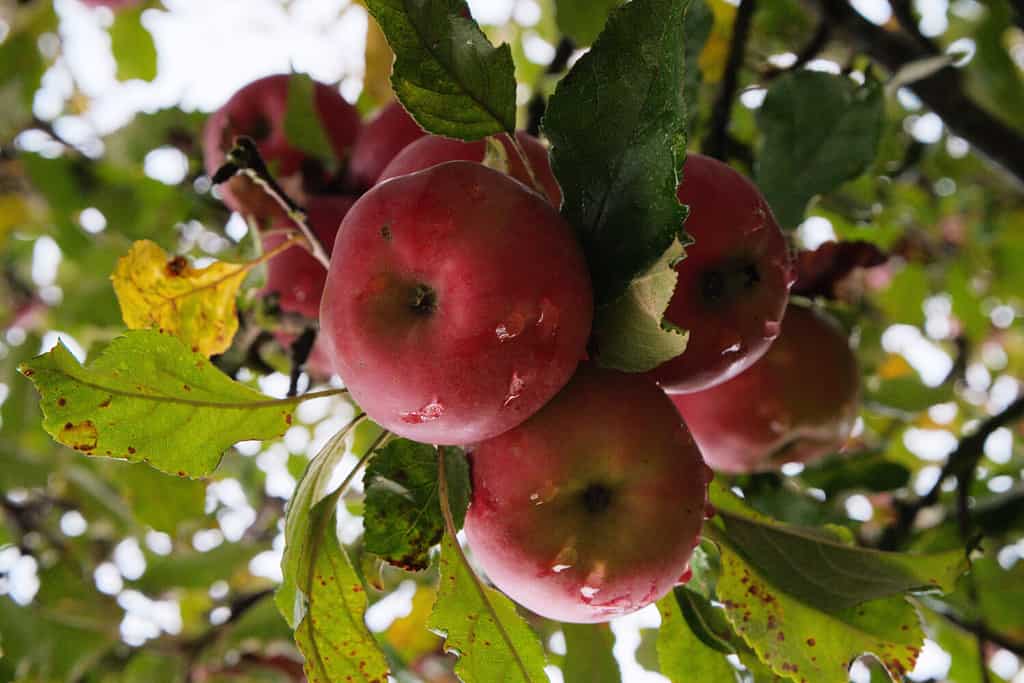
Many different varieties of apples thrive in different parts of Zone 8.
©CarlosR/Shutterstock.com
2. Peaches
Peaches flourish remarkably well in USDA Hardiness Zone 8 due to the combination of factors that create an ideal environment for their growth. One of the primary reasons for the success of peaches in Zone 8 is the favorable climate. The region experiences milder winters with sufficient chill hours, which are essential for peach trees to break dormancy and set fruit. Peaches require a specific amount of chilling time during the winter to ensure proper flowering and fruit production in the following growing season. The moderate winter temperatures in Zone 8 provide the ideal conditions for this process to occur effectively.
Moreover, the extended growing season in Zone 8 plays a crucial role in the success of peach cultivation. The longer period of warm weather allows peach trees to flower and fruit over an extended period, leading to better yields. The ample sunshine and heat during the growing season promote robust growth and contribute to the development of flavorful, juicy peaches.
Well-drained soils are another advantage of Zone 8 that benefit peach trees. Peaches prefer soil with good drainage to avoid waterlogged conditions, which can be detrimental to their roots. The well-draining soils in this zone allow the roots to access sufficient oxygen and nutrients, supporting healthy growth and development.
Also, peaches in Zone 8 are less susceptible to certain diseases and pests that thrive in more humid and warmer environments. While no location is entirely free from challenges, the relatively lower incidence of such issues in Zone 8 simplifies pest management and disease control for peach growers.
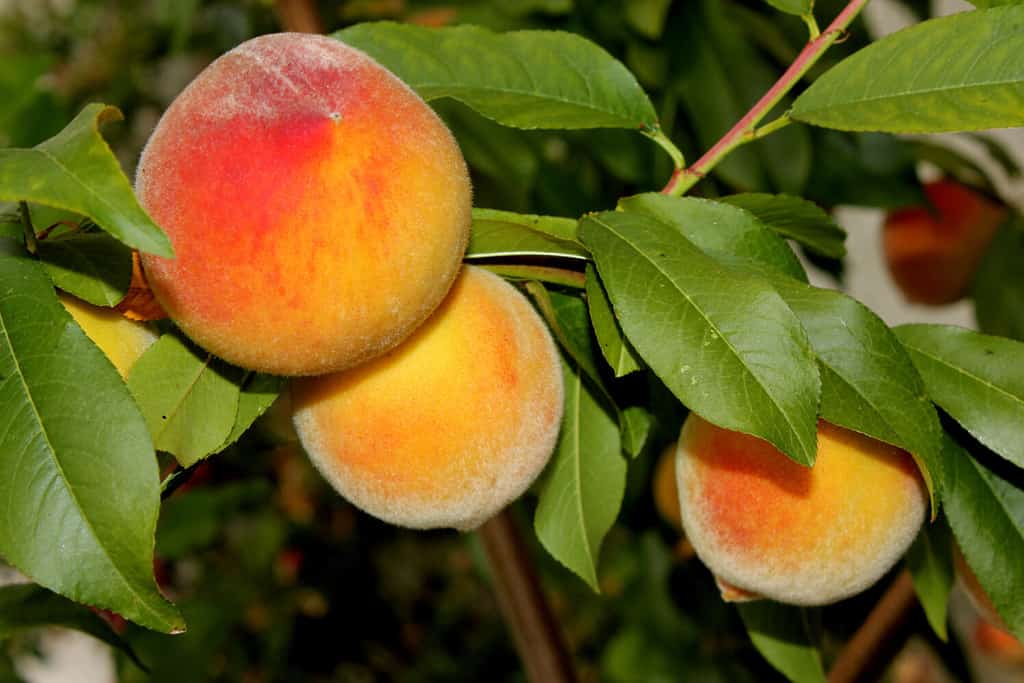
Peaches benefit greatly from the extended growing season of zone 8.
©Gurcharan Singh/Shutterstock.com
3. Pears
The moderate winter temperatures in Zone 8 play a crucial role in pear cultivation. Pears, like many fruit trees, require a period of winter chill (you’re probably starting to see a pattern here!) to break dormancy and prepare for the upcoming growing season. The mild winters in this zone provide the necessary cold temperatures, ensuring that pear trees undergo the required rest period. As a result, they are better prepared to bloom and set fruit when the warmer spring weather arrives.
Just as well, the extended growing season in Zone 8 is highly beneficial for pear trees. The longer period of warm weather allows for continuous flower and fruit development. This extended timeframe provides ample opportunities for pollination and fruit maturation, leading to higher yields and improved fruit quality. The additional warmth also contributes to the development of sweet, juicy pears with enhanced flavors.
Well-drained soils are another advantage of Zone 8 that promotes the thriving of pear trees. Pears prefer soil with good drainage, as waterlogged conditions can be detrimental to their root systems. The well-draining soils in this zone allow the roots to access oxygen and essential nutrients efficiently, supporting healthy growth and overall tree health.
Also, Zone 8’s climate helps to mitigate certain disease and pest issues that may pose challenges in more humid and warmer regions. While no location is entirely free from potential threats, the relatively lower incidence of such problems in Zone 8 simplifies pest management and disease control for pear growers.
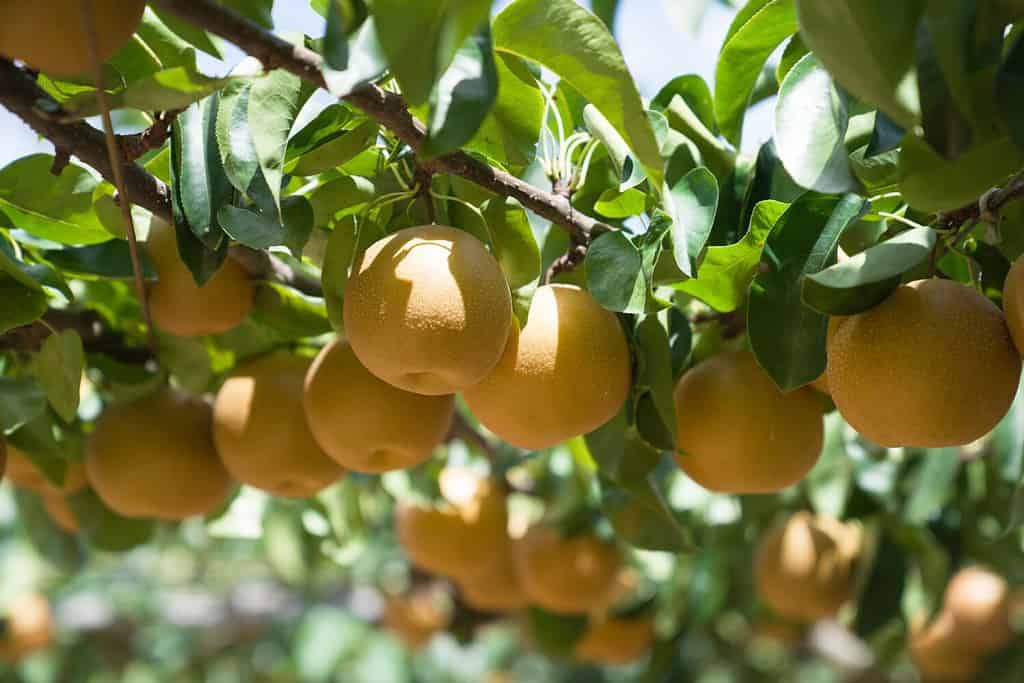
Pears benefit greatly from the lack of pests in Zone 8.
©Nikox2/Shutterstock.com
4. Figs
One of the primary reasons for the success of figs in Zone 8 is the moderate winter temperatures. Figs are hardy trees that can withstand a certain amount of cold, but they require protection from severe frost. Zone 8’s milder winters provide a suitable balance, offering enough chill to facilitate dormancy without subjecting the trees to extreme cold that could damage them. This ensures that fig trees remain healthy and are ready to sprout new growth when spring arrives.
Moreover, the extended growing season in Zone 8 is highly beneficial for fig cultivation. Figs need a long period of warm weather to develop and ripen their fruits fully. The longer, warmer summers in this zone allow fig trees to produce multiple crops of delectable fruits throughout the growing season. The additional sunshine and heat contribute to the sweetness and flavor of the figs.
Well-drained soils are another advantage of Zone 8 that supports fig tree growth. Figs prefer soil with good drainage to prevent waterlogged conditions, which could be harmful to their shallow root systems. The well-draining soils in this zone ensure that the roots receive adequate oxygen and nutrients, promoting healthy growth and overall tree vigor.
There are also not as many pests in zone 8 that would harm figs. While no location is entirely immune to challenges, the relatively reduced incidence of certain pests and diseases in this zone simplifies fig tree management and reduces the need for extensive chemical treatments.
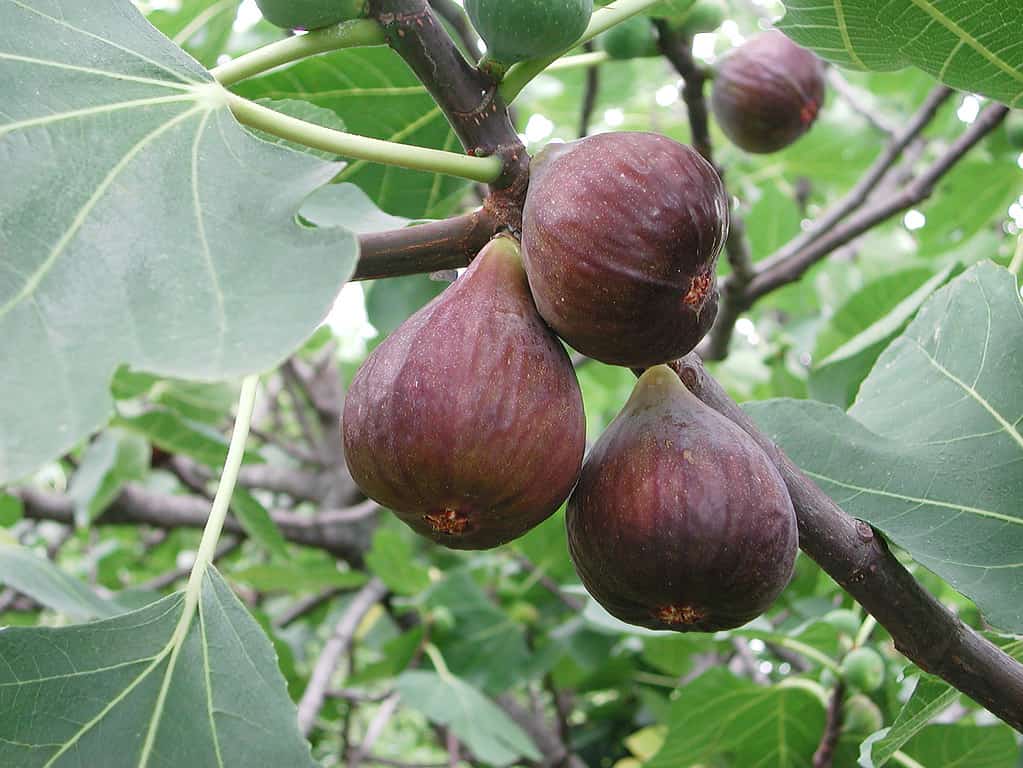
Figs do best in zone 8 but can also be grown in zones 7, 9, 10, 11, and 12.
©simona pavan/Shutterstock.com
5. Plums
The main reason why plums do so well in Zone 8 is the moderate winter temperatures. Plum trees require a certain amount of winter chill to break dormancy and prepare for the upcoming growing season. The relatively mild winters in this zone provide the necessary cold period, ensuring that plum trees undergo the required rest period. This prepares them for a vigorous bloom and fruit set when warmer spring temperatures arrive.
Moreover, the extended growing season in Zone 8 greatly benefits plum cultivation. Plum trees need an ample period of warm weather to flower, set fruit, and allow the fruits to mature properly. The longer, warmer summers in this zone create an optimal growing environment, supporting healthy tree growth and abundant fruit production. The additional sunshine and heat contribute to the development of juicy, flavorful plums.
The well-drained soils prevalent in Zone 8 are another advantage that fosters the successful growth of plum trees. Plums prefer soil with good drainage to prevent waterlogging, which can be detrimental to their root systems. The well-draining soils in this zone allow the roots to access sufficient oxygen and nutrients, ensuring the trees’ overall health and vitality.
Also, the lower pest and disease pressure in Zone 8 positively impacts plum trees. Although no location is entirely immune to challenges, the relatively reduced incidence of certain pests and diseases in this zone simplifies plum tree management and reduces the need for extensive chemical interventions.
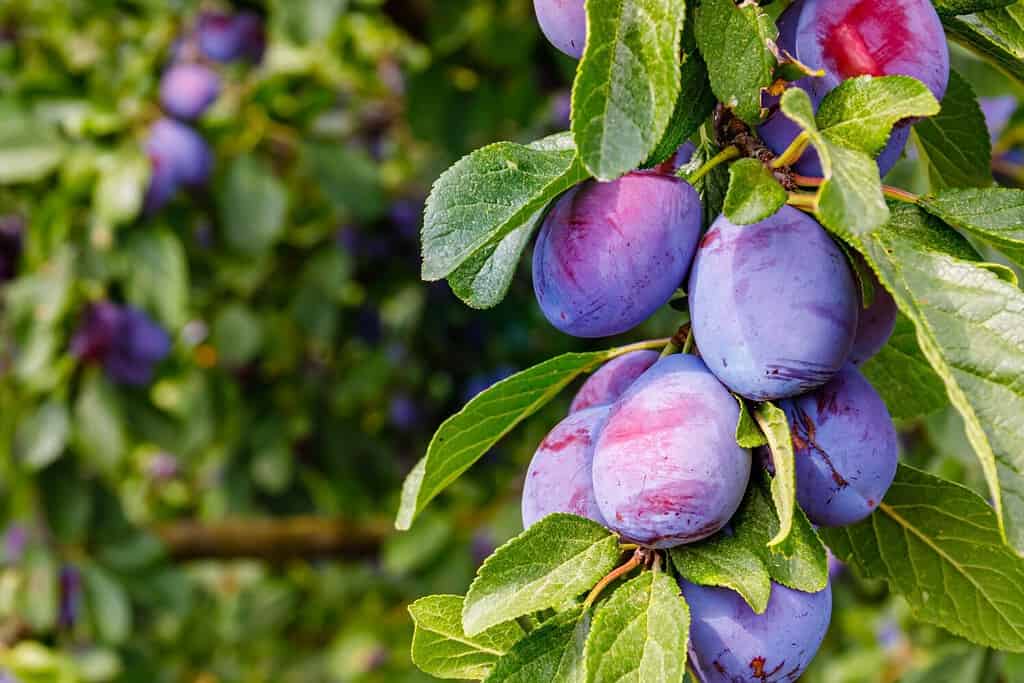
One will notice that there are many plum trees grown around the residential and commercial areas of Zone 8.
©nnattalli/Shutterstock.com
6. Cherries
Cherry trees require a period of winter chill to break dormancy and set the stage for the upcoming growing season. The relatively mild winters in this zone provide the necessary cold period, ensuring that cherry trees undergo the required rest period. This prepares them for vigorous flowering and fruit production when spring temperatures rise.
Moreover, the extended growing season in Zone 8 significantly benefits cherry cultivation. Cherry trees need a generous amount of warm weather to flower, set fruit, and allow the fruits to mature fully. The longer, warmer summers in this zone create an optimal growing environment, supporting healthy tree growth and abundant fruit production. The ample sunshine and warmth contribute to the development of plump, sweet cherries with delightful flavors.
The soil in Zone 8 is also ideal for cherry trees. Cherries thrive in soil with good drainage, which prevents waterlogged conditions that can harm their shallow root systems. The well-draining soils in this zone allow the roots to access sufficient oxygen and nutrients, ensuring the trees’ overall health and vitality.
As with many other trees on this list, the lack of pests in this zone positively impacts cherry trees. While no location is entirely immune to challenges, the relatively reduced incidence of certain pests and diseases in this zone simplifies cherry tree management and reduces the need for extensive chemical interventions.
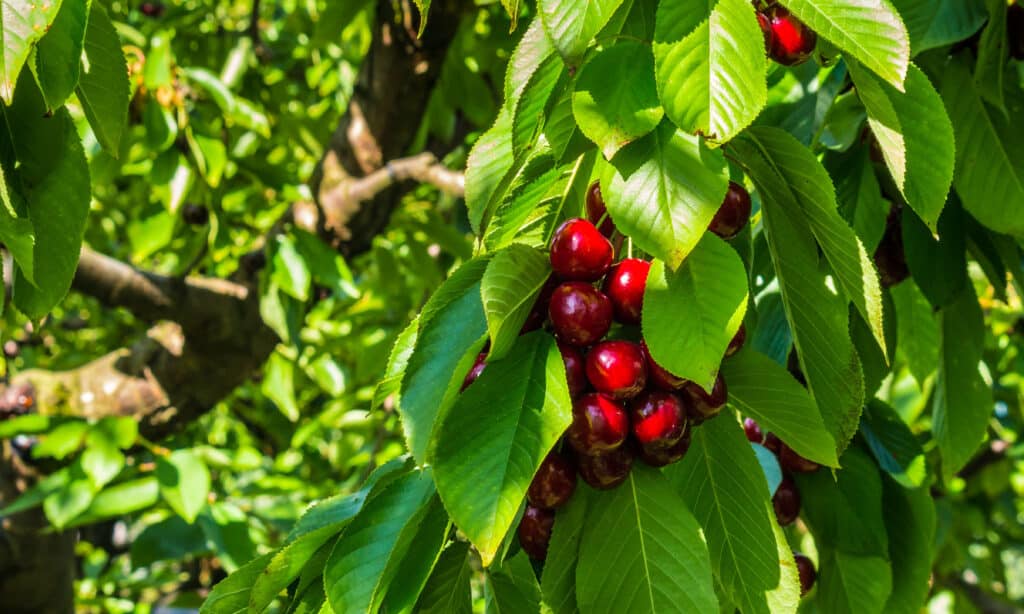
Cherry trees enjoy the soil quality provided by many areas of Zone 8.
©patjo/Shutterstock.com
7. Persimmon
One of the primary reasons for the success of persimmons in Zone 8 is the moderate winter temperatures. Persimmon trees require a certain amount of winter chill to break dormancy and prepare for the upcoming growing season. The relatively mild winters in this zone provide the necessary cold period, ensuring that persimmon trees undergo the required rest period. This prepares them for vigorous flowering and fruit production when spring temperatures rise.
Also, the extended growing season in Zone 8 greatly benefits persimmon cultivation. Persimmons need a generous amount of warm weather to develop and ripen their fruits fully. The longer, warmer summers in this zone create an optimal growing environment, supporting healthy tree growth and abundant fruit production. The additional sunshine and heat contribute to the development of luscious, flavorful persimmons.
The well-drained soils prevalent in Zone 8 are another advantage that makes it possible for the successful growth of persimmon trees. Persimmons thrive in soil with good drainage, which prevents waterlogged conditions that can harm their root systems. The well-draining soils in this zone allow the roots to access sufficient oxygen and nutrients, ensuring the trees’ overall health and vitality.
Yet again, the lower pest and disease pressure in Zone 8 positively impacts persimmon trees. Although no location is entirely free from challenges, the relatively reduced incidence of certain pests and diseases in this zone simplifies persimmon tree management and reduces the need for extensive chemical interventions.
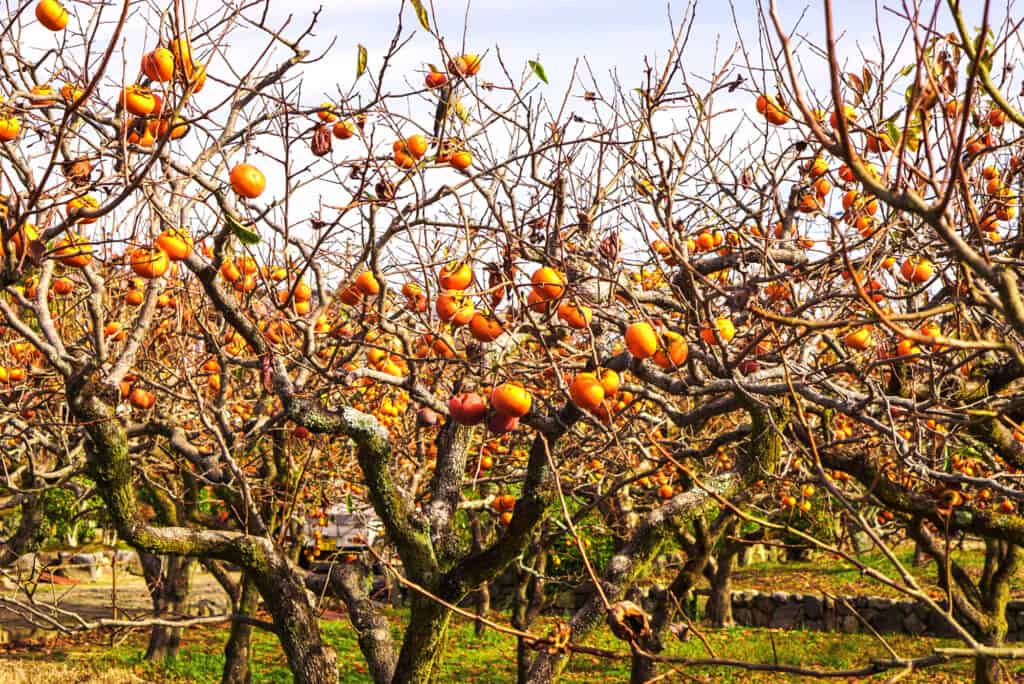
Persimmon trees are unique fruit trees that benefits greatly from Zone 8’s weather.
©iStock.com/Wiphop Sathawirawong
Summary of Fruits Trees Perfect for Zone 8
| # | Trees |
|---|---|
| 1 | Apples |
| 2 | Peaches |
| 3 | Pears |
| 4 | Figs |
| 5 | Plums |
| 6 | Cherries |
| 7 | Persimmon |
Thank you for reading! Have some feedback for us? Contact the AZ Animals editorial team.







